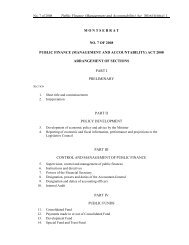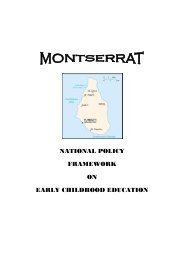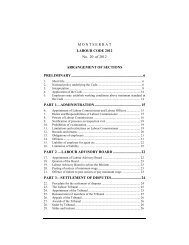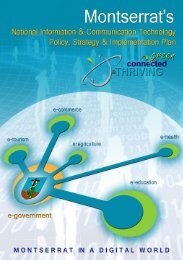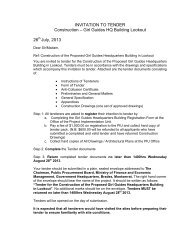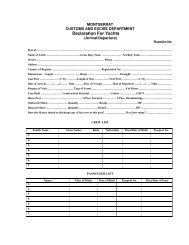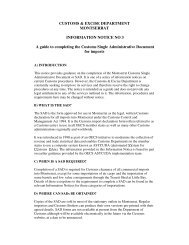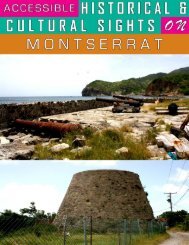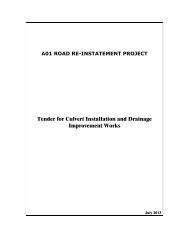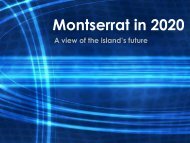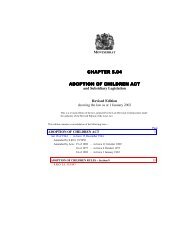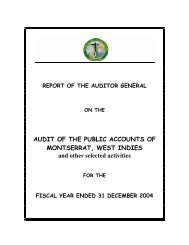Montserrat Survey of Living Conditions (MSLC) Executive Summary
Montserrat Survey of Living Conditions (MSLC) Executive Summary
Montserrat Survey of Living Conditions (MSLC) Executive Summary
Create successful ePaper yourself
Turn your PDF publications into a flip-book with our unique Google optimized e-Paper software.
<strong>Montserrat</strong> <strong>Survey</strong> <strong>of</strong> <strong>Living</strong> <strong>Conditions</strong><strong>Executive</strong> <strong>Summary</strong>Average household size was 2.4 persons in 2008/09 which, while low by Caribbean standards, is slightlyhigher than after the eruption when it dropped to 2.1 persons. The proportion <strong>of</strong> households withspouses/ partners has increased to 38%, much higher than in 2001 when it was only 29% while theproportion <strong>of</strong> single person households had decreased from almost 50% in 2001 to 35%. Around 40% <strong>of</strong>households are female-headed, similar to the 1991 proportion. All these indicators reinforce the view thatthe population structure <strong>of</strong> the island is gradually stabilising from its post-eruption structure when a largenumber <strong>of</strong> households fragmented.In 2008/09, 29% <strong>of</strong> household heads were foreign-born but a substantial proportion <strong>of</strong> these hadachieved belonger status. If this group is excluded, the proportion <strong>of</strong> non-national heads on the island isaround 15%.2.3 The EconomyThe economy <strong>of</strong> <strong>Montserrat</strong> today is the result <strong>of</strong> an array <strong>of</strong> unique factors and developments followingboth Hurricane Hugo and the volcanic eruptions in which social and economic structures and the island’sinfrastructure were decimated; large parts <strong>of</strong> the island were made (and remain to this day) uninhabitable.As a British Overseas Territory, <strong>Montserrat</strong> has been able to access loans and grants from the UnitedKingdom to rebuild and <strong>Montserrat</strong>ians were able to leave their homes for jobs and family in the UK,thereby decreasing pressure on the post-eruption economy. In consequence, the recovering economy isbased mainly on services (especially government) and construction, with little value added in the traditionalsectors <strong>of</strong> tourism and agriculture (Figure ES2).Through grants, loans and support from <strong>Montserrat</strong>ians living overseas, <strong>Montserrat</strong>ians have been able tomaintain a reasonable material lifestyle 3 , as measured by GDP per capita. In 2004, <strong>Montserrat</strong>ian GDP percapita in 2006 at around EC$22,000 was 50% higher than the ECCB average and 3 rd highest <strong>of</strong> the eightmember states.Nevertheless, the current weakness <strong>of</strong> the economy is evident. In 2006, in constant dollars, GDP was only53% <strong>of</strong> the level achieved in its pre-Hugo (1987) level (Figure ES3). Were it not for the fact that many<strong>Montserrat</strong>ians left the island following the volcanic activity, per capita economic activity would be muchlower. The recent sluggish performance is largely the result <strong>of</strong> some large public sector projects beingcompleted with only the mining and quarrying sector showing growth as a result <strong>of</strong> exports <strong>of</strong> volcanicsand. In 2008, the economy grew by around 4% but inflation almost reached 5% resulting in a decline inreal GDP 4 . ECCB forecasts that the economy will continue to remain flat in the near term; risinginternational oil prices and the North American recession will further increase consumer prices. TheGovernment <strong>of</strong> <strong>Montserrat</strong> is forecasting GDP growth <strong>of</strong> 3% in both 2008 and 2009 based on the startup<strong>of</strong> construction projects at Little Bay and Government Headquarters, among others.3 In 2008/09: 53% <strong>of</strong> households had a motor vehicle; over 85% had fridges, TVs and telephones (landline or cell);40% had computers with most <strong>of</strong> these having internet access.4 GOM, Budget Speech, 2009.<strong>Montserrat</strong> Country Poverty Assessment, Final ReportHalcrow Group Limited, July 2012.ES4




